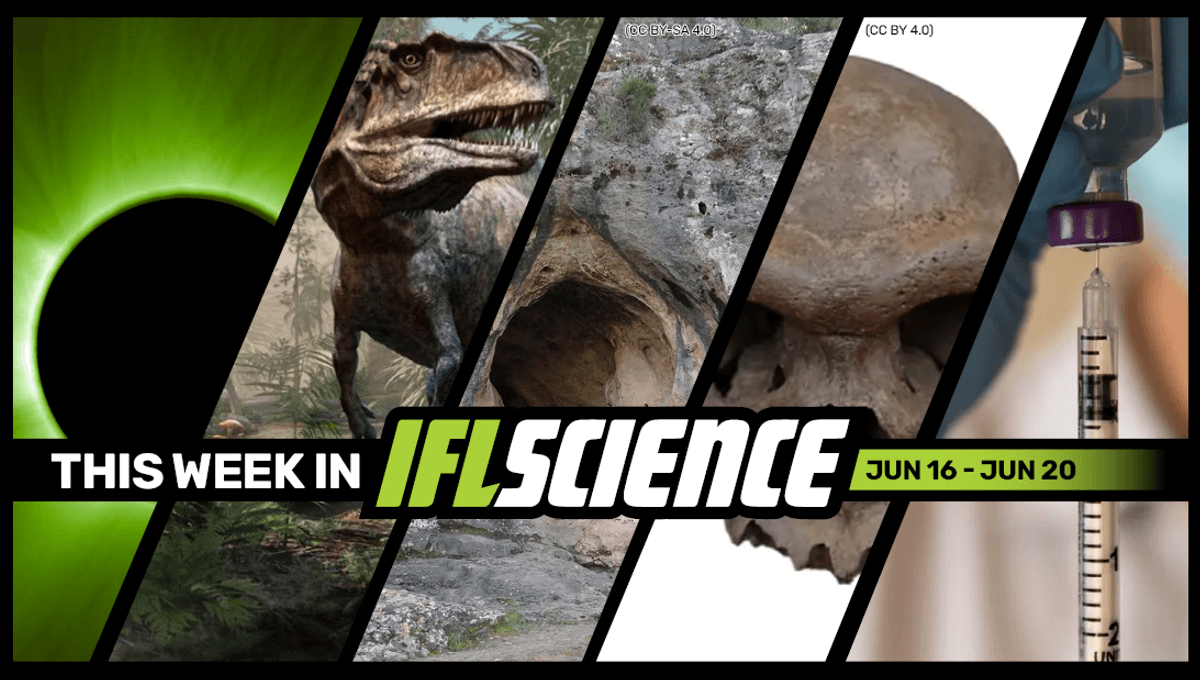-
Nieuws Feed
- EXPLORE
-
Pagina
-
Blogs
-
Forums
World First Artificial Solar Eclipse Created, The “Closest Thing” To HIV Vaccine Gets FDA Approval, And Much More This Week

World First Artificial Solar Eclipse Created, The “Closest Thing” To HIV Vaccine Gets FDA Approval, And Much More This Week
This week, a site in Colorado may have been used as the “largest lekking arena in the world” by dancing dinosaurs, a child from the world’s oldest burial was a Neanderthal-Homo sapiens hybrid, and scientists have at last identified the first Denisovan skull, despite it hiding in plain sight since 1933. Finally, on the 50th anniversary of the movie’s release, we discuss the impact JAWS has had on shark conservation and research.
Total solar eclipses are not just incredible celestial events. They are also important scientific moments that allow scientists to study the solar corona, the incredibly hot atmosphere of the Sun, probing its behavior. But solar eclipses do not happen every day, so the European Space Agency (ESA) decided to create an artificial eclipse using the Proba-3 mission, and photos of the very first one have just been shared. Read the full story here For clues as to how dinosaurs dated, we can look to the last living dinosaurs: birds. On Earth today, several species perform lek mating, a spectacular courtship display that sees males gather together for what is essentially a dance-off. Females will watch the males perform, and the most impressive wins the chance to mate with her. Sounds fun, right? And what’s even more delightful to contemplate is that this behavior was practiced by several dinosaur species, too. Read the full story here A little over 100,000 years ago, groups of prehistoric humans in the Levant suddenly began burying their dead, marking one of the most significant cognitive and behavioral leaps in the history of our species. Yet these primordial grave-diggers weren’t quite like us, and new research reveals that a young child from the world’s oldest cemetery may have been a Neanderthal-modern human hybrid. Read the full story here A near-complete skull of a Denisovan, one of the closest extinct relatives of modern humans, has never been recovered – or so it was thought. New research has shown that a cranium discovered nearly a century ago in China actually belongs to the little-understood human species/subspecies. The discovery means that science finally has a relatively complete skull of a Denisovan, allowing us to get a sense of what the mysterious relative might have looked like at last. Read the full story here The US Food and Drug Administration (FDA) has approved lenacapavir, an injectable drug that has been shown to act as pre-exposure prophylaxis (PrEP) to reduce the risk of sexually acquired HIV. The drug, which is being marketed by Gilead Sciences as Yeztugo, has shown a 99.9 percent prevention rate in a clinical trial involving people of all genders. Read the full story here JAWS changed the way movie-goers saw the ocean by creating a supervillain unlike any Hollywood had ever seen before. You see, this one was a big fish. On the 50th anniversary of the iconic movie, IFLScience chats with activist Wendy Benchley (wife of Jaws author Peter Benchley) and marine scientist Dr Lydia Koehler to discuss the film’s impact, legacy, and hope for sharks' futures. Read the full story here Have you seen our e-magazine, CURIOUS? Issue 35, June 2025, is available now. This month we asked, “Are There Colors That Only Exist In Our Brains?” – check it out for exclusive interviews, book excerpts, long reads, and more. PLUS, the We Have Questions podcast – an audio version of our coveted CURIOUS e-magazine column – continues. In episode 8, we ask, “Why Don’t Animals Have To Brush Their Teeth?” The Big Questions podcast has returned, and we’re kicking off season 5 with the big question: Would You Rather Go To Space Or The Bottom Of The Sea?Create an IFLScience account to get all the biggest science news delivered straight to your inbox every Wednesday and Saturday.
Solar Eclipses On Command? That's Now A Reality
Dancing Dinosaurs May Have Used Site In Colorado As “Largest Lekking Arena In The World”
Child From World’s Oldest Burial Was Neanderthal-Homo Sapiens Hybrid
Scientists Have Finally Identified A Denisovan Skull – It's Been Hiding In Plain Sight Since 1933
Revolutionary Drug That's “Closest Thing” To HIV Vaccine Gets FDA Approval
TWIS is published weekly on our Linkedin page, join us there for even more content.
Feature of the week:
“Some People Took JAWS As A License To Kill”: 50 Years On, Can We Turn Fear To Fascination?
More content:


